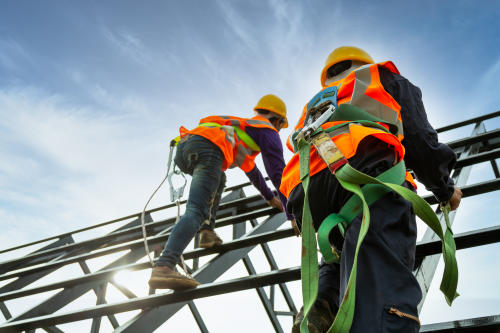Using Fall Protection: How to Reduce the Risk of Falling on Construction Job Sites

Preventing the risk of falling is always the best way to ensure the safety of workers on a jobsite. However, when risk cannot be prevented, reducing risk is the best way to keep workers safe. Falls are still the leading cause of fatalities on construction sites, despite how far the construction industry has come in safety and protection.
While Personal Fall Protection Equipment (PFPE) can be useful, it is important to understand that preventing and reducing risks of falling is always the best and most effective protection for employees on a jobsite. Companies should be invested in the attention to detail and planning required to ensure the safest possible conditions for workers.
The right time to use fall protection
Companies need to be aware and proactive about preventing falls. Some circumstances which create fall risk are not as obvious as others. Fall protection is needed when:
Working
from
heights:
This
might
seem
obvious
(working
on
the
scaffolding
of
a
high
rise
building
or
standing
on
a
mobile
elevated
work
platform),
but
some
high
places
in
need
of
fall
protection
can
be
less
apparent.
Working
near
an
excavation
area
can
create
a
risk
for
fall
despite
being
on
ground
level.
Using
or
working
on
fragile
materials
can
also
increase
risk
of
falling.
Finally,
working
near
a
hole
in
the
ground
or
a
floor
can
create
fall
risk.
OSHA
requires
fall
protection
when
workers
are
6ft
above
the
ground.
This
may
look
like
a
guard
rail
or
a
parapet
wall
no
matter
how
close
workers
are
to
the
edge.
Working
near
an
edge:
A
leading
edge
is
an
unprotected
edge
that
changes
as
construction
progresses.
Because
of
their
ever-shifting
locations,
companies
need
to
be
proactive
about
fall
protection
near
this
type
of
edge.
Working
on
steep
surfaces:
The
slope
of
the
steep
edge
(most
often
a
roof)
will
determine
the
need
for
guardrails,
safety
nets,
etc.
Steep
surfaces
affect
balance
and
therefore
require
thought
about
fall
protection.
Training
One of the greatest lines of defense is the training given to workers. Following and enforcing guidelines from OSHA and ANSI are the first level of preparation. Companies, however, can equip their employees more with training about the specific equipment either through a rental equipment company or through their own, skilled workers. For example, AMCHoist offers Crane and Load inspections. The American Society of Safety Professionals also offers a Minimum Requirements for a Comprehensive Managed Fall Protection Program (ANSI/ASSP Z359.2 – 2017) which can serve as a starting point to develop fall risk prevention and reduce risk.
Though there are many ways to develop such programs, a culture of safety is important to create on a construction site, and it has to be cultivated from the leadership. Leaders can encourage employees to follow program guidelines and value safety protocols that protect fellow workers. Company owners and leaders can participate in trainings and uphold safety standards alongside the workers on site to cultivate a culture that prevents and reduces fall risk. Listening to employees on site who are most at risk of falling is important as well for unnecessary injury.
Preventing falls
There is a hierarchy which helps in planning well for fall prevention. It includes the following four steps:
Elimination: Reduce or eliminate the amount of time a worker spends in a situation with risk of a fall. This means using machinery when possible to work with materials that are in more hazardous areas of a construction site. This can play out in many ways, for instance constructing something on the ground and lifting it with a crane to place it, rather than having workers construct the component in a hazardous area.
Passive
Fall
Protection:
This
is
known
by
many
other
terms
(prevention,
engineering
controls,
etc).
But
works
as
barriers
and
railings
that
keep
workers
from
falling
or
entering
dangerous
areas.
This
can
also
include
administrative
controls
such
as
warning
signs,
procedures,
rules,
and
training.
Fall
Restraint:
This
system
uses
a
tie-off
in
order
to
make
sure
that
the
workers
do
not
get
close
to
edges
they
could
fall
from.
It
helps
them
stay
close
to
the
safest
parts
of
a
high-risk
area.
Fall
Arrest:
Also
known
as
PFPE,
fall
arrest
is
the
least
effective
protection
against
injury
from
falling,
but
can
still
protect
a
worker
to
some
degree.
It
is
designed
to
stop
a
falling
worker
from
reaching
the
ground.
This
type
of
prevention
is
designed
as
a
harness
or
lanyard
and
requires
intensive
training
and
precautions
to
use.
Fall
arrest
should
never
be
the
only
method
of
protection
for
a
worker,
though
it
can
be
a
necessary
one.
The safety of workers on a construction site is one of the most important considerations and requires resources to plan well. Contact AMC Hoist for more information on trainings and inspections to ensure your site stays safe!
Contact Us | Hoists | Hoist Parts | Cranes | Beam Clamps | Inspections & Training | About Us | Customer Reviews | Privacy Policy | Shipping & Returns
Americrane & Hoist Corporation | 13311 Enterprise Ave | Cleveland, Ohio 44135 | Phone: 216-267-9100 | Fax: 216-267-9131
All Rights Reserved 2025, Americrane & Hoist Corporation
Admin Login | Web Site Developed by Alt Media Studios







